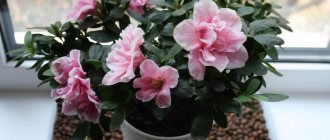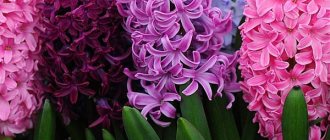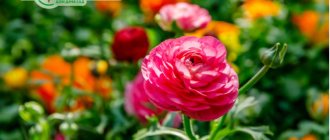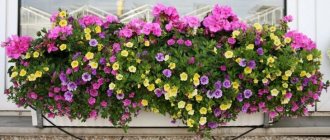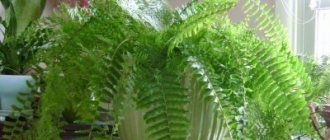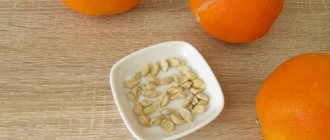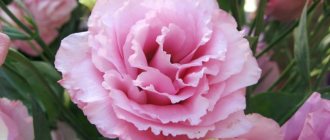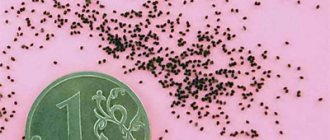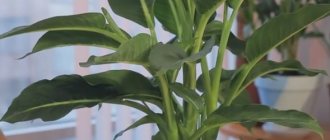Botanical description
Plectranthus (lat. Plectranthus) is a subtropical decorative deciduous semi-succulent plant.
The genus belongs to the Lamiaceae family, there are about 400 species in total.
It is characterized by:
- Height - from 15 to 100 cm.
- The stems are deep green or brownish-red in color, tetrahedral thin, often bare or covered with hairs, erect or creeping.
- The leaves are thick, fluffy with a strong scent, up to 10 cm in length. Rounded, heart-shaped, triangular with jagged edges, arranged crosswise.
- The root system is fibrous and goes shallow into the ground.
- Flowers are miniature bell-shaped buds of pink, white, lilac or violet, consisting of 5 petals fused at the base. They are located in racemose or umbrella-shaped inflorescences of 6-10 pieces each. After pollination, fruits with 4 nuts are formed.
You can learn about all types of mint here.
Trimming
Before intensive growth begins, the crown of the plant must be carefully trimmed. This will cause side shoots to grow.
Before the procedure, the pruning shears must be treated with alcohol, as the stem may be damaged (rotting will occur).
First of all, when pruning, you need to remove injured and weak branches. It is recommended to cut them to 2/3 of the length. There is no need to worry, as the cut shoots will quickly put out buds and begin to grow.
In ampelous crops, to enhance growth, you should lightly pinch the tips.
Since shrubby species grow quickly, they can be grown in the form of a ball. In this case, the lower leaves should be torn off, and the upper shoots should only be pinched.
To avoid rotting, it is best to sprinkle the cut area with charcoal powder, which has drying and antiseptic properties.
Useful properties and contraindications
The plant releases phytoncides that have an impact on the environment. Beneficial properties include:
- Improves the health of the air in the house by killing pathogenic bacteria.
- Repels moths, flies, mosquitoes and other insects.
- Has a medicinal effect.
- Increases a person’s well-being - considered another version of the “money tree”.
Plectranthus has contraindications:
- It is not recommended to take tea and its products for pregnant and lactating women and children under 12 years of age.
- May cause irritation to people with sensitive skin.
- May cause harm to hypotensive patients and people with varicose veins.
You can learn more about the benefits and harms of mint from this article.
What do signs say about the plant?
Positive superstitions
Superstitious people call plectranthus the money plant. Therefore, different types of flowers are grown both in homes and offices. Still would! The flowerpot helps solve work difficulties, pay off loans and solve any other financial problems, adds luck, and accelerates the advancement of its owner up the career ladder. Moreover, not only the person who cares for it, but also other inhabitants of the house/office come under the “protection” of the plant.
And magicians are sure that the flowerpot protects the house from various evil energies, even negative spirits and the evil eye.
Important: there is an opinion that only strong-willed, determined and courageous people should grow this plant. It is to them that plectranthus brings good luck. And besides, it promotes adventurous achievements and reasonable risks. Are you a pessimist who gives up at the first difficulties in life? In this case, the spur flower will refuse to play tricks on you.
If it is already helping (with the appearance of the plant in the house, you began to earn more, you quit your old business in favor of a new, better one, you feel an unprecedented ability to work), do not forget to properly care for the plant. After all, if in the heat of workaholism you abandon your green pet and it dries up, it will take revenge by taking away your success.
And when does plectranthus warn of danger?
If the plectranthus withers (or even worse, dies), neither luck nor wealth will shine for you. Most likely, the plant warns of future financial problems. Although it is possible that you are simply moving in the wrong direction - change your field of activity and you will live much richer.
Important: a withering and painful plectranthus should be removed from the house. Such a plant will only magnetize negativity.
Smell and taste
Plectranthus is a spicy-aromatic plant. Its leaves smell of camphor, lungwort and menthol notes with a mint aroma.
Plectranthus is aromatic in taste and smell, reminiscent of oregano and thyme and has a pleasant lemon-mint scent.
Decorative flower varieties: names and photos
Plectranthus is represented by numerous plant varieties. The most popular among them are several varieties.
Fragrant
Aromatic or fragrant plectranthus (lat. Plectranthus amboinicus) - can reach a height of 2 m. The stems are greenish-purple in color, the leaf plates are heart-shaped or round in shape with a blunt apex. Petioles with pubescence, flowers of a pale blue hue. It is this variety that is used to prepare decoctions and teas.
coleus-shaped
Plectranthus coleoides (lat. Plectranthus coleoides) - reaches a height of 1 m. The shoots are straight, tetrahedral with pubescence. The leaves are fleecy up to 8 cm with a crenate edge and a white border. The flowers are white.
Shrub or moth tree
Plectranthus fruticosus is a branched shrub. The height of the plant is about 100 cm, the stem is pubescent. The leaves are broadly oval in shape with a pointed tip, up to 10 cm long. The flowers are light blue.
The plant has a pungent odor that repels moths.
Ertendahl
Plectranthus oertendahlii (lat. Plectranthus oertendahlii) is a shrub up to 0.2 m high. It has creeping shoots up to 0.4 m long. The leaves are greenish-brown in color up to 6 cm, have a broadly ovate shape with a blunt apex. On the underside of the leaves there is light red pubescence. The leaf plates feel like velvet to the touch. The flowers are white or pale lilac bells, the length of the inflorescences is about 0.3 m.
Mona Lavender
Plectranthus Mona Lavender (lat. Plectranthus Mona Lavender) is an upright shrub, a hybrid. The stems are brownish-brown in color, the leaf blades are oval with jagged edges of a dark green color, shiny, on the underside they are purple with pubescence, odorless. The flowers are tubular-shaped bells of bluish-violet color with blue specks.
Hadiensis (felt)
Plectranthus hadiensis (lat. Plectranthus hadiensis) - reaches a height of 0.7 m. The leaves are fleshy, light green, broadly ovoid in shape. The stems and leaves are pubescent. Flower color is purple.
With age, the trunk becomes woody.
Ernst
Ernst's plectranthus (lat. Plectranthus ernestii) is a perennial subshrub that reaches a height of 0.5 m. In its lower part, the stems form a gray-yellow ten-centimeter trunk - the caudex. The leaves are light green, oval-shaped, serrated. The flowers are white, lilac-blue.
Forster
Plectranthus forsteri (lat. Plectranthus forsteri) is a horizontal plant, its stems cascade and reach a length of 1 m. The leaf blades are green, oval with small villi, covered with large white spots. Exudes the smell of camphor. The flowers are white.
Whorled
Plectranthus verticillatus is a semi-shrub plant. Height from 50 to 150 cm. Distinguished by the purple color of the stems. The leaves are ovate with a rounded top, bright green. The leaf may have pubescence on the front side and red veins on the back. Inflorescences are small racemes of white or pink-purple color.
Southern
Southern plectranthus, or Scandinavian ivy (lat. Plectranthus australis) - bright green foliage with a waxy coating. The leaf shape is round, the edges are jagged. Leaf length is up to 7 cm. The stems are weak, hanging down under the weight of the foliage.
The peculiarity of the plant is the absence of odor from the leaves.
Oakleaf
Plectranthus venteri is a plant with erect stems. The leaves are leathery, covered with silvery hair and shaped like oak foliage, exuding a pine aroma. The plant has whorled inflorescences on long stalks - delicate blue flowers.
general information
In nature, plectranthus is common in Asia, Africa and Australia, but it has long taken root well in our latitudes. It is also popularly called spur flower because of the specific shape of the corolla. Indoors, plectranthus blooms towards the end of winter.
Due to its characteristic aroma, plectranthus is often called homemade mint. Despite the fact that this is a flowering plant, it is valued primarily for its beautiful leaves, which form a lush and spectacular crown.
The height of the bush in indoor conditions rarely exceeds 80 cm, and usually it is even less. Plectranthus is very branched, with strong fibrous roots and ribbed shoots. But the leaves are completely different in shape, structure and color.
Photo: zelenj.ru
Potty care at home
Plectranthus is an unpretentious plant, its care includes:
- Temperature regime - comfort temperature 20-22 °C; in winter, colder conditions are acceptable, but not lower than 15 °C. Does not tolerate dry hot air.
- Watering - during the growth period it requires abundant watering, especially at air temperatures above 22 ° C. In winter, it is enough to water once every 4 days to avoid stagnation of water and rotting.
- Location - window sill with good lighting, but without direct exposure to sunlight. In this case, the leaves retain their rich color. In the sun they turn yellow and curl.
- Container - high pots - for the normal development of a powerful root system.
- The soil is loose, well permeable to air and moisture.
- Reproduction - cuttings.
- Diseases - downy mildew develops in damp, cold environmental conditions.
Caring for the plant at home includes replanting and pruning.
Transfer
The plant is replanted in the spring before it reaches 5 years of age. For replanting, use a pot slightly larger in diameter than the previous one. Drainage is placed at the bottom.
On the day before planting, the plant is watered abundantly. After removal, the plectranthus is placed in a new pot along with a lump of earth, without destroying the lump.
Add ready-made nutrient soil to empty spaces or make it yourself from humus, turf, leaf soil, river sand and peat in a ratio of 2:2:1:0.5:0.5.
When the plant reaches 5 years of age, replanting is carried out as necessary.
Trimming
At the end of winter - beginning of spring, pruning is carried out. At the same time, old stems are removed. The plant rejuvenates and produces new shoots. In order to form a beautiful ornamental bush during the period of active growth, pinching is carried out.
Read more about caring for and growing plants on a windowsill here.
Reproduction methods
The easiest way to propagate the variety you like is to use cuttings or divide an adult bush. The seed method takes longer and the seeds are not always available for sale, and it is difficult to prepare them yourself.
Cuttings
You can cut cuttings (length 7-8 cm) at any time, using a strong, healthy shoot as a basis. The lower leaves are cut off, and to stimulate root growth, the cuttings are placed in a solution of Kornevin or Epin for 1-2 hours. It is recommended to root in a loose, damp mixture consisting of peat and sand.
Information!
It is convenient to combine the preparation of cuttings with pruning when the crown is formed in the spring, removing too long shoots.
The container is placed in a cool room in diffused light. Care consists of regularly moistening the substrate. When the roots appear and the stem begins to grow, you need to pinch the top. Seedlings are planted several in one pot to form a lush bush. Fertilizers begin to be applied after 1.5 months.
Delenki
A convenient moment for dividing the bush is replanting. Divide an adult, overgrown plant with a developed root system. The instrument must be sharp so as not to disrupt the patency of the capillaries in the tissues. The sections are treated with coal powder or ash.
The roots need to be inspected, damaged, rotten, diseased areas should be removed, and the cuts should be sprinkled with ash. The division is planted in a separate container, the size of which is slightly larger than the size of the root system. If a composition is made, then it is planted in a pot with another plant.
Seeds
Sowing of seeds is carried out in mid-April or early May, using low containers with a lid. The substrate for germination is prepared from peat and sand and moistened before sowing.
Procedure:
- distribute the seeds evenly over the surface, press lightly without covering them with soil;
- Close the container with a lid and place in a warm (20-24 °C) bright place, but not in direct sunlight;
- moisten the soil regularly, open the lid to remove condensation;
- when shoots appear, remove the cover;
- Transplant into separate containers a month after the sprouts appear.
Other uses
Plectranthus is not registered in the register of medicines, but is widely used in folk medicine as an anti-inflammatory, diuretic, antimicrobial, expectorant, and analgesic. Decoctions of the leaves are used for mosquito bites, midges, insomnia and nervous fatigue.
In cooking it is used as a substitute for oregano for beef, lamb and poultry dishes. Dried leaves are used in everyday life, the aroma of which repels mosquitoes, flies and moths, and promotes concentration when working on the computer. In cosmetology it is used to shine and restore split ends of hair.
Only Plectranthus aromaticum is used for food and medicinal purposes.
Plectranthus – photo
The plectranthus genus is so diverse that you can find more than a dozen varieties that are completely different from each other. Just look how beautiful it is!
Photo: flowersweb.info
Photo: greenboom.ru
Photo: rastenievod.com
Photo: leplants.ru
Photo: commons.wikimedia.org
Photo: na-dache.pro
Photo: samson-school.ru
Photo: uz.crushingplants.info
Photo: alternativeeden.com
Photo: m.alibaba.com
Photo: water-vao.ru
Photo: youtube.com
Photo: pelargoniumpl.blogspot.com
Photo: komnatnyecvety.ru
Photo: nuestraflora.com
Photo: houseplants.studleys.com
Photo: commons.m.wikimedia.org
Photo: ru.m.wikipedia.org
Photo: ethno2.ethno-botanik.org
Photo: pixabay.com
Photo: shop.zelmir.by
Photo: sortved.ru
Photo: uz.crushingplants.info
Photo: glav-dacha.ru
Photo: zen.yandex.ru
Did you like the post? Subscribe to our channel in Yandex.Zen, it really helps us in our development!
Transfer
Due to rapid growth, the crop must be replanted annually. The container should be 3cm larger than the root ball. In this case, it is important to inspect the root part for the absence of diseases, pests and damage.
After four years, the plant must be replanted every two years. Transplantation is best done in the spring before rapid growth begins.
Growth periods (rest, flowering)
By nature, plectranthus does not need a period of rest. But you can create peace yourself. To do this, in winter you need to reduce watering and stop feeding.
Flowering usually occurs in summer. At this time, small inflorescences appear in the form of spikelets. Since flowers take a lot of energy from the crop, it is recommended to prune them.
